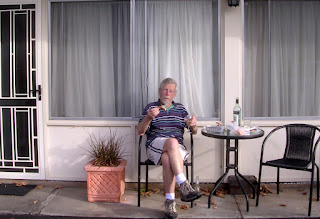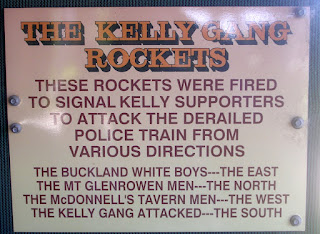The Snowies to Melbourne
This section of our journey took us two days: the distance is close to 600 kilometres (this—remember—is a big country and we are just down in a small part the south-east corner).
The first 100 km took us along the Alpine Way, for which we were prepared by the direst warnings of twisty, curving, narrow roads, steep inclines, rock-falls, wildlife on the loose—name a danger, and we had been warned. Bit of an anti-climax really. I have driven on more difficult roads in Devon. But there were steep inclines and spectacular scenery—at least we thought there must be, although much of it was fogged in. Any pictures we tried to take looked like this one on the left.
Towards the end of the drive along the Alpine Way we visited one of the power houses of the SnowyHydro system, where the turbines were run from a huge pipeline coming down from a lake much higher up in the mountains.
After the Alpine Way we drove through the Murray River Valley, and then it began to rain, and rain, and rain. Someone had suggested we HAD to see Beechworth, which was a big centre of the Ovens Gold Fields during the 1850’s and 1860’s, with a population of some 40,000 and 61 hotels—it is now much reduced in population. There was a festival on there—Opera in the Alps. We puttered around in the rain looking at the junk and gift shops and ate Lamingtons at a famous old bakery.(as the Madeleine is to Proust, apparently the Lamington is to Australians—a little Victorian sponge cake coated in chocolate icing and shredded coconut). There were a few older Victorian buildings that spoke to a more prosperous past.
We stayed the night in Wangaratta at the cheapest motel we have used so far. We have noted, incidentally, that the more modern the hotels or motels, the more fancy but impractical are the bathrooms—lots of mirrors to capture you in various positions, but no shower curtains or place to put toiletries round a hand basin, or to put down the soap when you are in the shower. But this cheap little place had a great bathroom.
For evening meals we have often been to stores and bought a few things, and in Wangaratta we visited a Safeway and bought half a cooked chicken, some salad materials, apples, tinned fruit, and yogurt. Up to the time we exited the supermarket, the rain had been sweeping down, but miraculously it stopped as if a tap was turned off; and by the time we walked the few hundred yards back to our cheap motel, the sun was blazing down and we sat outside our room, eating our food and chatting with the motor cyclists (tattooed, shaven heads, earrings, Harleys, little German-type helmets) who were the only other occupants of the ten little rooms that constituted the motel.
In the morning, we drove into two towns on our way to Melbourne. A small one—Glenrowan—and a much larger one—Benalla, which has a very attractive Art Gallery, the supports of which were being lapped by a slightly flooded Lake Benalla.
On the side of one wall of the gallery was an aboriginal painting, and on the other a picture devoted to the life of –guess who?—the famous Edward (Ned) Kelly, a cross between Robin Hood and Jessie James.
Ned’s most notable mark on the artistic life of Australia was his home-made armour—immortalised by the Australian painter, Sidney Nolan. In the Art Gallery in Canberra, there is a series of some 20 odd paintings by Nolan showing the life of Ned Kelly, always shown with the weird armour on his head.
He was both a friend of the poor Irish farmers and a scourge of the (mainly) English police, a couple of whom he killed. The towns we had visited vie for the Ned Kelly tourist trade. In Beechworth, from the courthouse from which poor Ned was committed to trial in Melbourne, we saw some good Ned Kelly sculptures and many other forms of up-market Ned stuff in fancy gift stores. But Joan noted a statue in Beechworth that was worth a picture.
But the Ned capital of tourist kitsch was in Glenrowan, the site of Ned’s last stand against the police—complicated story, supposedly a planned ambush of a train, with rockets to be set off to alert Ned when the train arrived, or something like that.
Dominating one end of the one-or-two street town is a huge Ned statue outside what can only be described as an emporium of Ned kitsch, mostly made in China. We both felt we should photograph each other to give an idea of the size of this monstrosity.
But that was just the most schlocky memento of the man who was hanged in Melbourne Gaol in 1880, with a crowd of 4,000 sympathisers demonstrating outside to support him. They saw Ned as justifiably rebelling against English-based law (in relation to property holdings on small farms) and the repressive police authorities.
As you walked along the main street, Ned was everywhere you turned your eyes. Where was Joan turning her eyes?
















No comments:
Post a Comment